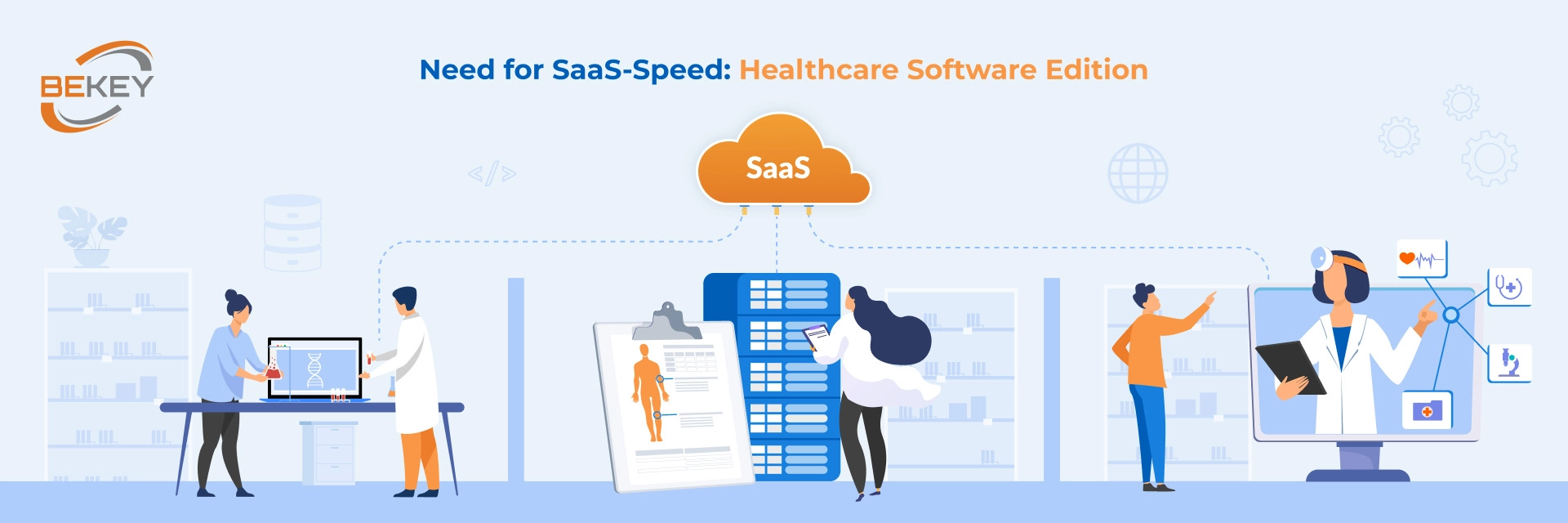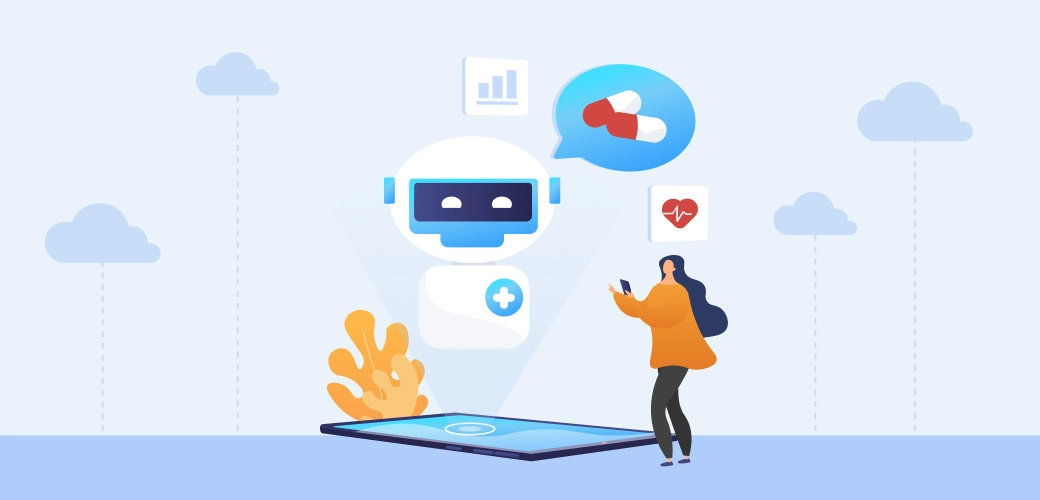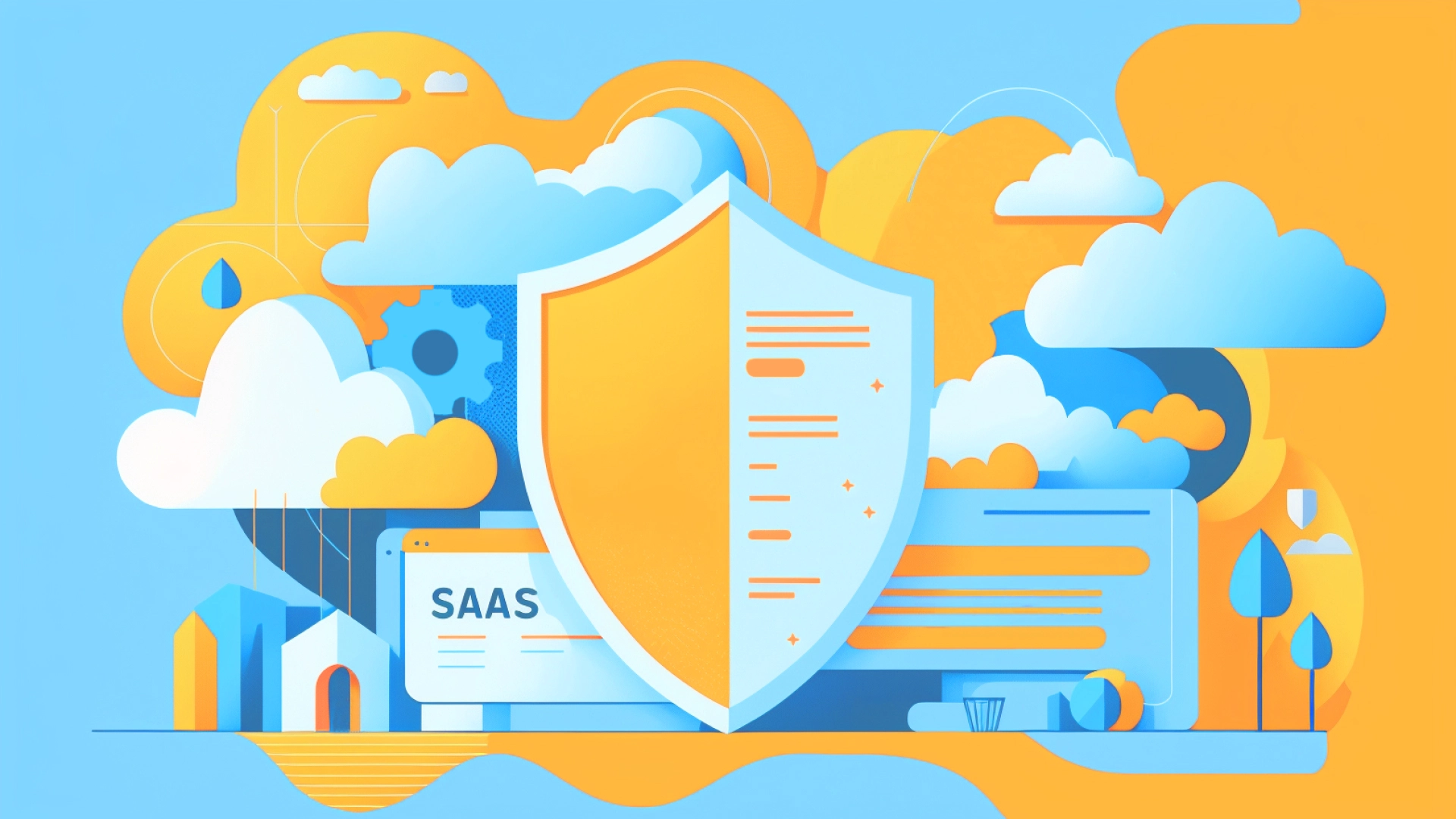

Need for SaaS-Speed: Healthcare Software Edition
The development of cloud technologies, their scalability, flexibility, and ease of use force industries in various sectors to choose this path. SaaS (Software-as-a-Service) is one of three main categories of cloud computing, alongside infrastructure as a service (IaaS) and platform as a service (PaaS). The SaaS model of cloud services currently drives the cloud computing market, especially in the healthcare industry. SaaS-based healthcare technology solutions demonstrate the potential for hospitals to provide timely and quality services. Let’s talk about the advantages of clouds in the healthcare field and the trends for the near future.
A number of years ago, the “cloud scenario” seemed like an absolute fantasy. Currently, it is implemented in narrow and specific areas. Healthcare software-as-a-service initially faced a backlash over security concerns. Today, with safeguards in place and developed, healthcare businesses are beginning to see the benefits.
Healthcare organizations are turning to SaaS as a more affordable way to deploy EHRs (Electronic Health Records). SaaS applications include EMRs (electronic medical records), EHRs, PACS (Picture Archiving and Communication System), and telemedicine. Some preclinical information systems include RCM (Reliability Centered Maintenance), billing, supply chain, etc.
Healthcare SaaS Market and Its Trends
In the future, SaaS in healthcare will become more common due to its cost, security, and scalability advantages. Zion Market Research has estimated the global healthcare cloud computing market at approximately $18 billion. They expect the market to generate around $61 billion by 2025. Part of this growth is due to the COVID-19 pandemic, which has exposed weaknesses in the health care infrastructure and challenges faced by professionals even in a technologically rich world.
We have reached a stage where the cloud is poised to dominate the medical technology industry globally. Through 2025 and beyond, you can expect to see some of the next SaaS trends in healthcare.
Artificial intelligence (AI) rules
Artificial intelligence is ready to become an undeniable leader in the market with smart business applications. Integrating AI into SaaS allows them to become more autonomous. Many successful technology companies are automating business processes with AI, thereby increasing productivity and efficiency. The impact of AI through natural language processing (NLP) and machine learning (ML) is transforming care delivery.
ML uses algorithms to analyze data and discover patterns. It can process large amounts of data, learn from it, and make predictions. This allows systems to act according to the situation without being explicitly programmed to perform specific actions.

On the other hand, the pattern recognition function allows companies to configure their machines for a predetermined purpose. The system can notify administrators when something happens.
Healthcare SaaS businesses can benefit from AI automation in a number of ways:
Chatbots
Chatbots offer instant conversational responses and make connecting relatively easy for patients. Because chatbots take a holistic approach to communication, they encourage patients to actively share information about their health. This allows healthcare providers to improve patient care, reduce costs and increase patient satisfaction. In this way, artificial intelligence ensures a smooth flow and automation of primary care, leaving doctors to focus more on critical cases.
Virtual Nursing Assistants
From interacting with patients to directing them to the most effective and best care, virtual nurses can save the healthcare industry $20 billion annually. They can observe patients, answer their questions, and therefore offer quick answers in real-time. AI-powered virtual assistants provide patients with a personalized experience by helping them identify their illness based on symptoms, in addition to booking appointments and monitoring their health.
Precision medicine
The foundation of such medicine relies on large amounts of data collected through several revolutionary technological innovations, such as low-cost genome sequencing, advanced biotechnologies, and health sensors used by patients at home. Thus, it uses the cognitive abilities of doctors on a new scale. The goal of this way of using AI is to create a cognitive assistant armed with a range of clinical knowledge in addition to reasoning and analytical skills.
Assistance in the administrative work process
Service providers prioritize urgent tasks, helping doctors, assistants, and nurses save time on routine work. Technologies such as voice-to-text offer assistance in the administrative side of healthcare. They help automate non-patient care activities such as ordering tests, prescribing medications, and writing chart notes.
Multiple clouds
Multi-cloud means that a company uses several different public clouds, rather than mixing private and public ones. While the pros and cons of each cloud architecture are worth considering, multi-cloud environments can be more cost-effective than other options while providing additional scalability and security in healthcare. With multiple cloud providers, companies can expand their ability to store, process, analyze and protect critical medical data. An exciting move has been seen with APIs like Google Health. This has allowed companies to unlock the real value of medical data by using big data in different ways.
Attention on safety
Data security is a major concern for healthcare providers worldwide. As patient health records are digitized and placed in the cloud, there are concerns about data breaches in the cloud. It’s important to have a security model in place that can track traffic and data as it moves to and from the cloud.

Using a multi-cloud approach has its advantages. However, there is also the potential for new security complications.
You may find that these complications are becoming more common as companies move from understanding Infrastructure as a Service (laaS) in a single cloud to understanding how PaaS and SaaS can work together.
Vertical SaaS
Vertical SaaS is industry-specific software. While many SaaS applications can be used across sectors, vertical SaaS specializes in a specific niche, such as healthcare.
Because SaaS companies occupy a niche in an industry, vertical SaaS products can focus on a specific problem or need in the industry. Companies can tailor their products to target customers and supply chains. This level of product personalization reduces costs for both SaaS providers and consumers.
For the medical sphere, the healthcare vertical SaaS can pave the way for more targeted solutions that meet the needs of healthcare providers and services.
Vertical SaaS products will more accurately meet needs and increase consumer productivity and efficiency while keeping costs low because consumers can pay for the services they need or want. A healthcare vertical SaaS can address pain points in specific and targeted ways.
Need for API connections
The next big wave of healthcare SaaS is API (Application Programming Interface). With the growing use of SaaS in healthcare, there is a growing need to integrate it into existing business systems.
API-based products are more extensible, easier to embed and foster a larger community around potential use cases. So, APIs can no longer be a thing of the future — they must become an important part of your strategy.
While some organizations prefer to migrate their data to another cloud platform completely, some prefer to harmonize their data with their existing infrastructure. However, there is no reliable way to integrate the data fully.
For this reason, many healthcare organizations rely on SaaS providers to provide them with advanced integration capabilities.
Transition to a PaaS landscape
You can expect SaaS to move towards a PaaS (Platform as a Service) landscape. Many developers specialize in custom healthcare software development and focus on patient retention and engagement, making PaaS more attractive.
PaaS allows companies and organizations to build their own applications and include a software development kit. Mid-sized medical practices with a decent-sized IT department can benefit from dedicated wellness programs.
Micro-benefits of Micro-SaaS
Have you heard of micro-SaaS? Well, micro-SaaS companies are usually run by small teams of just two employees.
Products typically offered by such companies include free additions to current developments and existing platforms. However, add-ons are quite attractive as they help improve missing features and enhance current SaaS products.
You can find such miniature SaaS offerings in 2022 and beyond. According to Spok’s survey, about 63% of hospitals used six or more SaaS applications. As a healthcare company owner, you can consider using micro-SaaS and enjoy the benefits.
Transforming healthcare with edge computing
Edge computing is poised to become the must-have data generation engine for big data in healthcare. According to Forrester, nearly 27% of global telecommunications decision-makers said they intend to expand or use edge computing in their operations.
Dr. David K. Klonoff, medical director of the Diabetes Research Institute at Mills-Peninsula Medical Center, reiterated that edge computing and fog computing have advantages such as:
high data transfer rate;
less dependence on limited bandwidth;
reduced costs.
Klonoff cited the example of intensive care unit (ICU) sensors that require immediate data analysis and command execution, such as closed-loop systems that maintain physiological homeostasis.
As sensors become more sophisticated, there will be a need for such devices to track insulin levels, neurological activity, gastrointestinal function, and more.
Forward-thinking healthcare organizations will consider edge computing and experience its transformative power.
Fee Usage
SaaS providers typically operate on subscription models. They charge users a certain amount per month or year for using their services. The model makes it useful for both customers and suppliers.
But recently, many providers have switched to a pay-per-use (PPU) model. The payment model is especially good for healthcare companies that offer temporary services.
DaaS Revenues
With the increasing use of artificial intelligence, about 30% of enterprises will begin to generate revenue from data as a service (DaaS) in 2022 and beyond.
The study also highlights that around 75% of commercial business solutions will be integrated with artificial intelligence, and more than 50% of users will encounter it at some point.
The trends are encouraging for healthcare organizations and will cause a significant paradigm shift.
Summing up
The healthcare cloud computing market, especially SaaS, is growing. Why? It has the power to help overcome the deep-rooted infrastructural and administrative challenges faced by the healthcare industry, which largely depends on seamless inter-departmental collaboration, quality administration, and transparency.
SaaS-based cloud solutions can keep all stakeholders in an organization connected and offer scalability, data security, and flexibility. Especially in those healthcare facilities that are under constant high pressure, SaaS can help overcome obstacles such as poor infrastructure, data availability issues, etc.
Do you work in healthcare? Then it’s time to contact us and speak about an easy-to-use and highly effective SaaS application for your healthcare business!
Tell us about your project
Fill out the form or contact us

Thank you
Your submission is received and we will contact you soon
Follow us

